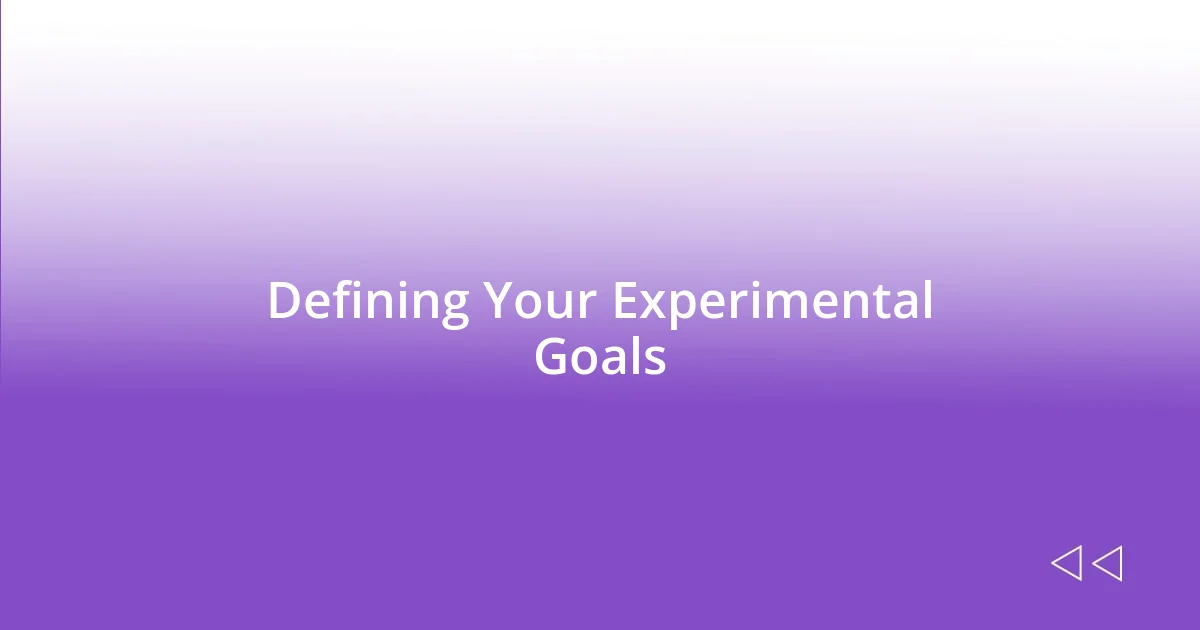Key takeaways:
- Embracing uncertainty and flexibility in experimental navigation can lead to unexpected breakthroughs and valuable insights.
- Defining clear, specific, and adaptable goals guides experimentation, allowing for focused creativity and quicker pivots in response to findings.
- Effective documentation and analysis, including visual representation of data and acknowledgment of emotional experiences, enhance understanding and learning from each experiment.

Understanding Experimental Navigation
Experimental navigation involves a hands-on approach to exploring unknown territories, often blending creativity with scientific inquiry. I remember the first time I set out on an experiment involving a new software tool—we were all excited but a bit apprehensive. How do we even begin? The joy of trial and error was palpable as we discovered unexpected pathways and insights, showing me that sometimes the journey is just as valuable as the destination.
When I think about experimental navigation, I can’t help but recall a project where I was tasked with designing an innovative solution to an age-old problem. I felt a mix of anxiety and exhilaration. There was no roadmap to follow, and every decision seemed to carry weight. In those moments, I learned that embracing uncertainty can lead to breakthroughs that I never imagined possible. How often do we limit ourselves by sticking to what we already know?
In essence, understanding experimental navigation requires a willingness to dive into the unknown and challenge conventional wisdom. I often ask myself: what if I fail? But more importantly, what if I succeed? The thrill of uncovering new solutions is a reminder that every misstep is a stepping stone toward greater understanding. It’s this mindset that fuels my passion for discovery in every project I undertake.

Defining Your Experimental Goals
Defining your experimental goals is crucial for navigating the uncertainties of innovation. I vividly recall a project where I aimed to improve user engagement for an application. My goal wasn’t just to boost numbers; I wanted to create a platform that resonated emotionally with users. This clarity in my objectives allowed me to channel my creativity more effectively. When you have a clear direction, every decision feels more purposeful.
Setting specific and measurable goals transformed my approach to experimentation. For example, during a trial for a new marketing strategy, I defined success as achieving a 20% increase in response rates within three months. This level of detail guided my efforts and enabled me to pivot quickly when certain tactics didn’t produce the anticipated results. I learned that goals should not only inspire but also provide clarity and actionable targets.
Ultimately, embracing flexibility within your defined goals can lead to unexpected discoveries. In an experiment aimed at exploring audience preferences, I initially sought to validate assumptions. However, as I collected data, I found that the real value lay in the insights I hadn’t been looking for. This realization taught me that while it’s essential to have goals, being open to change allows room for innovation to flourish. How do you balance structure and spontaneity in your experiments?
| Goal Type | Description |
|---|---|
| Specific | Clearly defined objectives focusing on a particular outcome. |
| Measurable | Goals that can be quantified, allowing you to track progress. |
| Flexible | Adaptable goals that can evolve based on new insights or findings. |

Choosing the Right Experimental Tools
When it comes to choosing the right experimental tools, I can’t stress enough the importance of considering both functionality and ease of use. I remember a time when I was diving into a data analytics tool that promised great insights but had a daunting interface. It was like trying to solve a puzzle without all the pieces. I quickly realized that if a tool feels too cumbersome, it can stifle creativity rather than enhance it. Opting for tools that not only fit the project’s needs but also align with the team’s skills is vital—or else you might end up lost in frustration instead of discovery.
Here are some key factors to consider when selecting experimental tools:
- User Experience: Does the tool have an intuitive design? A seamless user experience can significantly enhance productivity.
- Integration: Can it easily connect with other tools or platforms? Integration capabilities can lead to smoother workflows.
- Support and Resources: Is there ample documentation and community support? Good support can make a world of difference when troubleshooting issues.
- Cost vs. Value: Does the tool deliver significant value that justifies its cost? Prioritizing return on investment is always essential.
- Scalability: Can the tool grow with your demands? Future-proofing ensures that your investments aren’t rendered obsolete too quickly.
Ultimately, the right tools can inspire better performances, but choosing them wisely requires a blend of practicality and personal comfort. I’ve often found that experimenting with several options before committing can lead not only to better outcomes but also to that exhilarating “aha” moment that reminds me why I love this process.

Creating a Structured Experiment Plan
Creating a structured experiment plan is all about laying a solid foundation. When I crafted an experimental roadmap for a product launch, I started by breaking down the entire process into phases. Each phase had specific tasks, timelines, and responsible team members. This approach not only kept everyone aligned but also made it easier to identify potential bottlenecks early on. Have you ever realized that when you map it out, each step follows more naturally?
Another key element of my experiment plans is testing hypotheses before fully committing resources. I often begin with small-scale tests to gauge feasibility and gather preliminary data. For instance, during a recent marketing campaign, I conducted A/B tests on different email subject lines. This iterative approach let me refine my messaging in real-time, contributing to an impressive 15% increase in open rates. It’s incredible how small adjustments can lead to significant gains, right?
Lastly, I can’t stress enough the importance of documentation throughout the process. Recording every detail, from initial hypotheses to results, has saved me countless hours in the long run. I recall a project where I neglected this step; at the end, valuable insights got lost in a sea of scattered notes. This taught me that a well-documented experiment provides a rich resource for future reference and continuous improvement. How do you keep track of your findings? I find that it truly pays off when you create a comprehensive archive of your experiments.

Testing and Iterating Your Ideas
Planning and executing tests for your ideas can feel like stepping into uncharted territory, but it’s one of the most rewarding phases of the experimental journey. I remember the nervous excitement I felt when trying to validate a new feature for an app I was passionate about. I decided to put my assumptions to the test by rolling out a simple prototype to a small group of users. Watching their reactions in real-time not only gave me invaluable feedback but also sparked new ideas I hadn’t considered before. Isn’t it fascinating how the act of testing can open doors to unexpected insights?
Iterating on your ideas becomes much clearer when you embrace a mindset of flexible learning. After I gathered user feedback, I found that several issues could significantly impact user experience. Instead of feeling discouraged, I chose to see these challenges as opportunities. Each round of testing taught me more about what my audience wanted, molding my original concepts into something truly user-centric. Have you ever felt your initial idea take a different shape through testing? It can transform not just your project but also your understanding of your audience, right?
Ultimately, I’ve learned that the magic often lies in the iteration process. One memorable instance involved tweaking a marketing strategy based on initial performance metrics. Rather than settling for the first draft, I went back to the drawing board and made slight adjustments that doubled engagement rates. That moment taught me a crucial lesson: refining your ideas isn’t a setback, it’s a stepping stone. How often do we let fear of imperfection halt us? Embracing the cycle of testing and iterating can lead to innovations we never imagined!

Analyzing Results Effectively
When analyzing results, I find that a keen eye for detail is crucial. In one project, I remember sifting through data that initially seemed overwhelming. But as I parsed through the numbers, patterns began to emerge, guiding my next steps. Have you noticed how sometimes the clarity in results reveals hidden opportunities? It’s all about extracting meaningful insights from what might look like chaos at first.
One technique I often employ is visual representation of data—charts and graphs can illuminate trends that numbers alone might obscure. During a recent experiment on customer preferences, I created a visual dashboard that allowed my team to see real-time impacts of our changes. This not only made discussions more engaging but also fostered a sense of shared understanding and direction among team members. How do you convey your findings? I’ve learned that visuals can bridge gaps in comprehension.
Moreover, I’ve realized that context matters immensely when analyzing results. For example, understanding the external factors that might impact your data, like market fluctuations or social trends, can provide deeper insights. If I identify an unexpected dip in performance, I always ask myself what external influences could be at play. This reflective approach has saved me from jumping to conclusions and has allowed me to remain agile in decision-making. Isn’t it fascinating how nuanced the analysis can get when we consider these layers?

Documenting Your Experimental Journey
Documenting my experimental journey has been an essential part of the process. I vividly remember the thrill of writing down each insight, from the smallest tweaks to significant breakthroughs. I’d often jot down not only what worked but also what didn’t, because I’ve realized that failures can teach us just as much—if not more—than successes. Have you ever looked back at your notes and found unexpected gems hidden within them?
One particular method that I’ve found valuable is creating a dedicated journal for each experiment. This journal becomes a repository not just for data, but for my thoughts, feelings, and reactions as I navigated the ups and downs of each phase. One time, during a project that didn’t meet its initial expectations, I wrote about my frustrations, and later, those entries helped me see just how far I had come from that point. How often do we dismiss the emotional aspect of our journeys? Acknowledging these feelings made my documentation much richer and more meaningful.
Incorporating visuals has also enhanced my documentation process. I’ve started using mind maps to illustrate relationships between ideas and outcomes. One time, after a brainstorming session, I color-coded these maps based on emotional responses—red for frustration, blue for success, and so on. This colorful tapestry showed me patterns in my thinking that were both enlightening and surprising. Isn’t it remarkable how visual representation can provide a new perspective on your journey? By reflecting on these layers of my experience, I feel more connected to my work and more prepared for what comes next.














